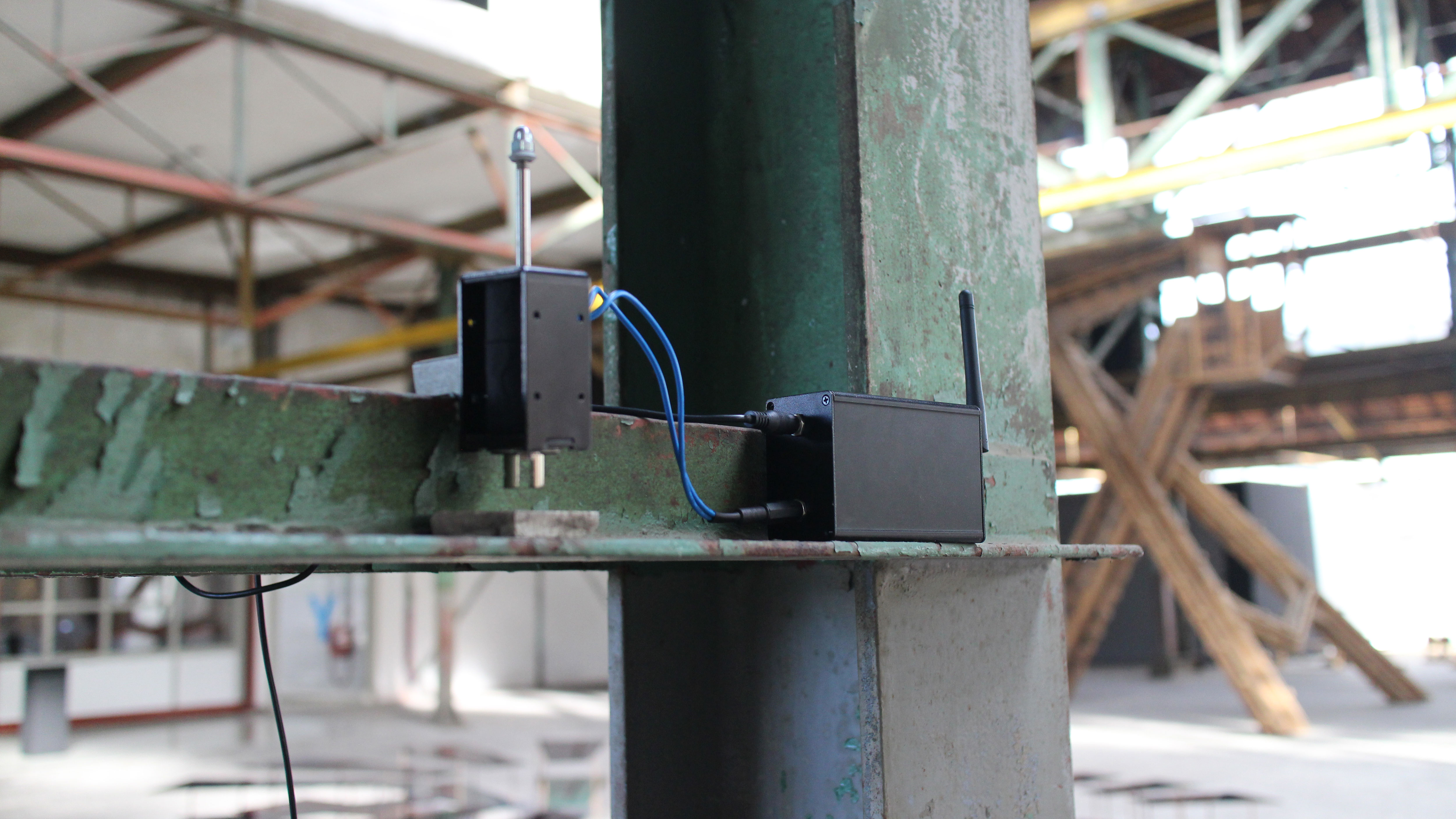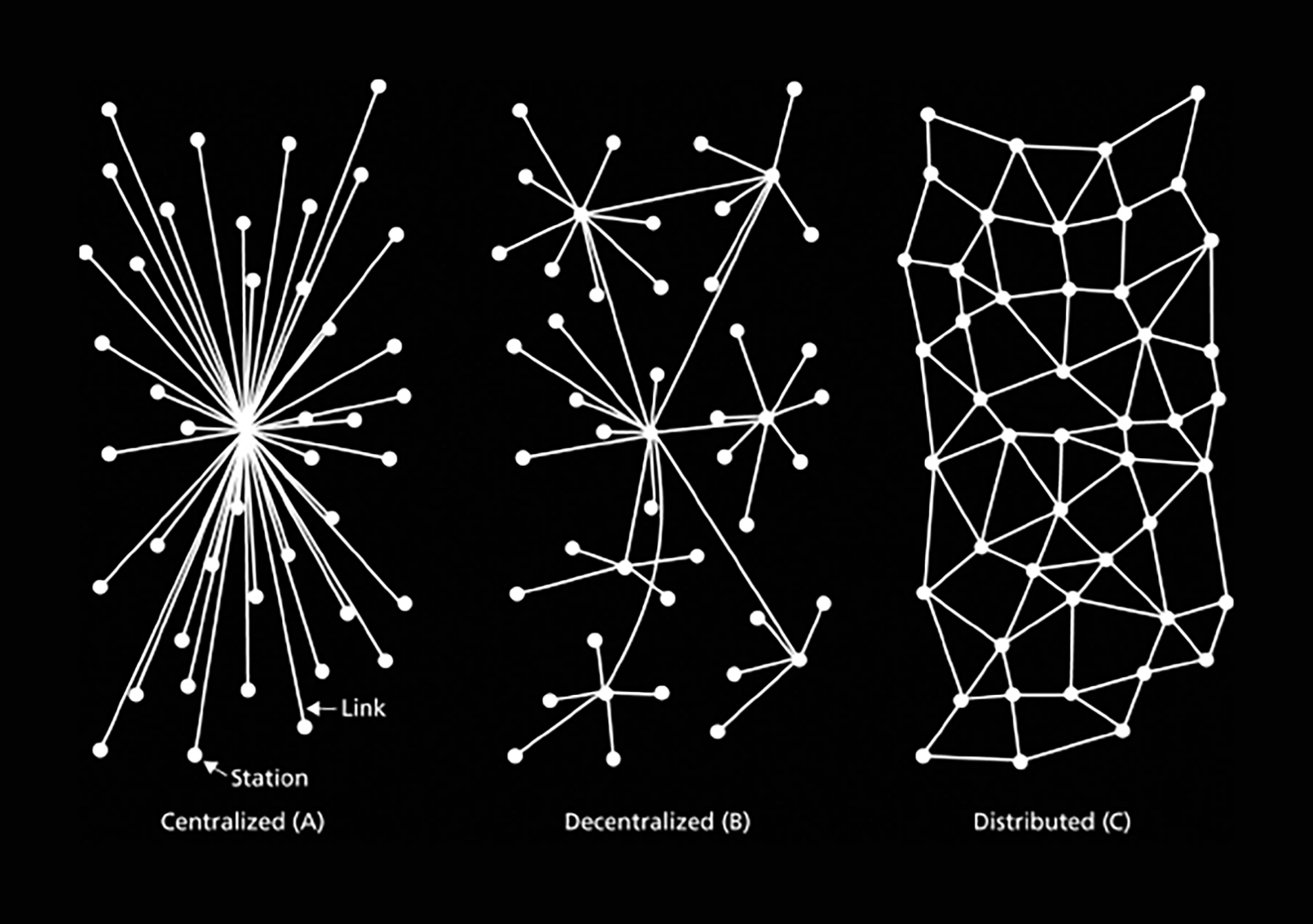On Nodes
This essay is one part autopoetic introduction to Hrvoje Hiršl's sound installation Nodes, and one part critique of a system that exploits artists' work.

Nodes are by definition devices or data points on a larger network. In computer science they are physical objects like servers, cell phones, printers… in network science they are abstract entities representing connection points, redistribution points or communication endpoints - meaning something that is merging, branching or intersecting.

From On Distributed Communications by Paul Baran, 1964 – This draft represents three types of networks: the star (centralized), the tree (decentralized) and the mesh (distributed) network. This was the basis for ARPANET developed in 1969 that later served as technological foundation for the Internet.
Networks represent interconnection between things and a study of those networks is called network science and examines telecommunication networks, computer networks, biological networks, cognitive and semantic networks, and social networks in search for different patterns and behaviors. It has been present since the 18th century but the field has exploded since the 90s when important discoveries were made on how many things in nature and society function according to different principles and those principles enable to predict, construct and run (cybernetics) different systems, or at least give an illusion of doing so…
In Second order Cybernetics it is stated that the observer is always a part of the system and therefore unable to understand it. The viewer is always influenced and is influencing the system. The system is not something separate from us, we are always a part of it. We don’t have a possibility of stepping outside of it to study it from the distance. There is no objective truth, no right point of view.
This becomes perfectly clear in case of www, a system we are intrinsic part of. We get daily crowd sourced, data mined, quantified, analyzed. We input data and interact with humans and machines, we teach algorithms how to perform better, we are feeding them so they could develop and grow, and we are very rarely aware of it, and what this really means, or where it is leading.
Concept
The work Nodes from 2015 represents a modular system, a set of devices transferring intangible information onto a physical space. Nods project invisible structures and networks and materialize them in the form of impulses. Those impulses represent stream of data that otherwise would be only perceivable as an abstract idea but not really experientially tangible. The goal is to connect the intangible data with action, to understand the relation of numbers, not only as symbolical value but also as objects. The Nods are converters. They translate the stream of data into a physical form and project it onto the space of the reality.
There is a division, a wrong perception of the relation between the physical and the virtual even though they are intrinsically linked, they are a part of the same system. The virtual is the abstraction of the real, an abstract representation that is not limited by the restrictions of the physical and can be freely manipulated with. All the information that are distributed, traded, mined and processed have a tendency in a basis of the physical world. They float in the cloud until they land and convert into action. In the world of ubiquitous computing that entered in every pore of our society we can’t pretend that if we ignore it, it will not apply to us.
Production
The first incarnation of the work Nodes was constructed during a residency in Dordtyart centrum, a converted former Biesboschhal shipping yard located in Dordrecht, a small city in the province of South Holland. The residency extended over a period of three months, an appropriate amount of time for developing a new and complex work. The work transferred the fluctuations of the financial market of top ten biggest shipyards, all of them in Asia, onto the structural steel columns of the Dordtyart building. The aim was to symbolically connect the past, the previous function of the Dordtyard building (the shipyard), and the present, the influence of the financial market onto the physical space and the distribution of labor.
The characteristic steel construction of the early 20th century industrial space and the historical context of the building immediately resonated acoustically and conceptually as the main theme of the project. The space, because of its huge size, mostly hosts works of larger scale that are commissioned by the organization annually. My budget, as a resident, was drastically smaller then the one from the commissioned artists and that imposed a serious consideration for a strategy that would enable me to do a work that would maximally engage the space and its history and at the same time would work inside the budget constraints.
Another important factor was transportation. I had an ambition of constructing a big size work, which would to be scalable. The scalability of the Nodes is another connection with the Network science. In 1999 Albert-Laszlo Barabási discovered the low of scale free networks, which says that the structure of the network is the same at all the possible scales. This applies to Web, economic exchange networks, social networks, ecosystems… It was only logical to apply the same rules of the network in the work about those networks.
In this venture I had an extensive contribution of labor and knowledge from a fellow artist Luis Rodil-Fernández, who, besides being an excellent artist and a thinker, is also a software expert and knows his way around electronics. Our conversations during the past two year of our friendship stimulated me greatly. One of the reasons for choosing a residency in Netherlands was to have an opportunity to continue our conversations and finally lay the foundation for our collaborative project algoresearch.systems, a platform dealing precisely with the same subjects that Nodes represent.
The Labor-Paradox
In the world after ready made, conceptual art and so many “posts” and “post-posts”, it is simply impossible to list them all, not to mention more than 60 years of computer science and network-science, it is ridiculous to think about the work in the sense of a stable form or a final piece. The abstraction of physical is so present in our daily lives that we even find our being extremely limited and annoying. The fact that we can’t be copied, easily repaired or duplicated is an object of frustration announcing our obsolescence. The soul has been replaced by consciousness and our consciousness wants to be free, it is envious of our digital selves.
Why then the art should limit itself to the 19th century way of thinking and acting!?
From the very start the terms and criteria of the residency were vague and at the service of the host. Finally the questionable competence of the organizers culminated on the final day when the artist is supposed to get an appropriate fee for its work. After three months of research, testing and building the system and after the hosts made it clear that they were satisfied with the site specific work that I had developed for them, I was informed that I would get just a fraction of the possible fee because I hadn’t worked enough with my hands. Apparently I didn’t portray enough of an artist stereotype: being dirty, smeared with paint, always cutting, welding or chiseling something…
This is the facebook post that I published on the 29th of September 2015 after being informed of this unpredicted and unfortunate development of events:
Another residency is finished and unfortunately a bitter taste has spoiled the final exhibition and the end of the residency that was already marked with constant struggle with the unsupportive institution. It was obvious from the start that something was wrong when they said that I would receive an artist fee depending on my “engagement”, assessed by no people from the media art field. I must admit I was blinded by the gorgeous exhibition space and great artists that have shown their work there, but I was just thinking I was paranoid.
Today, two days after the opening and on the final day of my residency they told me that they would pay me the minimum amount of €500 and not the maximum of €1500 for the artist fee of the residency because I worked a lot on my computer and not enough with my hands, according to their judgment. At the same time, ironically, they wanted to keep my work there until the end of the exhibition term because, as they said, they liked it. I am really sick of these exploitatory institutions that use artists for their promotion and public image without properly compensating artist’s work and masking it in some vague terms that enable them to do what ever they want.
Another huge irony is that my installation for the DordtYart institution is site specific and deals with the changes of labor and financial markets in the last fifty years. It is ridiculous that the digital work dealing with the physicality of the digital can be undervalued for being digital. Furthermore, DordtYart invited me and if they had looked at my application they could have known what kind of artistic practice I am engaged in, so it shouldn’t come as a surprise for them.
Dear colleagues and friends please let’s discuss this topic a bit more and please share your opinions and experiences related to the subject. I am sure we all have something to say because it affects us all! Edward A. Shanken,Josephine Bosma, Jon Cates, Wendy Coones, Jonas Lund, Natalia Fuchs,Wineke Gartz, Gabey Tjon, Luis Rodil-Fernández, Martijn van Boven,Domenico Quaranta, Robin Peckham, Venus Lau, Neural Revue, Peter Flemming, Swintak Swintak, TeZ Maurizio Martinucci, Marnix de Nijs, Paul Prudence, Manuel Beltrán, Guilherme Kujawski, Kelani Nichole, Jan Robert Leegte...
Of course I took my existing installation down. I would like to make another “site specific” work for the institution of DordtYart, a collaborative one, in the form of this post and share it publicly so these things don’t happen that often, artists are too often scared of these situations because they believe they will not be invited by other institutions if they complain.
In Galerija Nova, integrated in the exhibition Heroic Exhaustion (11.12.2015.-30.1.2016.), Nods took on a role of documentation and illustrated the gap in understanding of labor. I was presenting a work inside of a work. Along with the documentation of the development process of the Nods installation I presented a sub project (www.butttton.com) reflecting on the different aspects of the economy of labor and the physicality of the digital.
I find it paradoxical and worrying how narrow the knowledge of the general public is about something that all of us are so much a part of.

Project butttton.com uses mechanical turk workers, working for micro wage to get clicks that manifest themselves in the space of the gallery as physical hits. As the workers are concerned, the butttton could be just a button doing nothing, or collecting clicks, random number generator, a sociological experiment, an homage to Sisyphus, or maybe a morbid tele-murdering machine comparable to the drone attacks or an automated machine gun somewhere randomly killing people, or just a joke, or Santiago Sierra may have started doing net art…
︎
